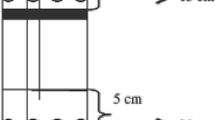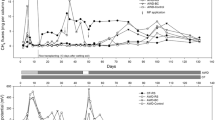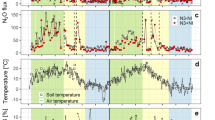Abstract
N2O emission from a wetland rice soil as affected by the application of three controlled-availability fertilizers (CAFs) and urea was investigated through a pot experiment. N2O fluxes from the N fertilized paddy soil averaged 44.8–69.3 μg N m–2 h–1 during the rice growing season, accounting for 0.28–0.51% of the applied N. The emission primarily occurred during the mid-season aeration (MSA) and the subsequent re-flooding period. Fluxes were highly correlated with the NO3 – and N2O concentrations in the soil water. As there were relatively large amounts of NH4 +-N present in the soil of the CAF treatments at the beginning of MSA, leading to large amounts of NO3 –-N during the MSA and the subsequent re-flooding period, the tested CAFs were not effective in reducing N2O emission from this paddy soil. The potential of applied CAFs to reduce N2O emissions from paddy soil is discussed.
Similar content being viewed by others
Author information
Authors and Affiliations
Additional information
Received: 25 May 1999
Rights and permissions
About this article
Cite this article
Yan, X., Du, L., Shi, S. et al. Nitrous oxide emission from wetland rice soil as affected by the application of controlled-availability fertilizers and mid-season aeration. Biol Fertil Soils 32, 60–66 (2000). https://doi.org/10.1007/s003740000215
Issue Date:
DOI: https://doi.org/10.1007/s003740000215




